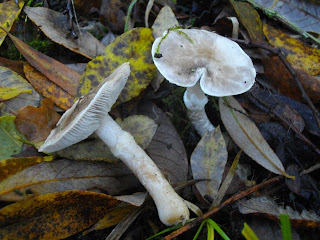13th November 2016
After a busy week I was looking forward to getting to Whitlingham to carry out the November WeBS count. The Velvet Scoter found mid-week was still present on Saturday at dusk, and various other winter birds had been seen in the past few days, including flyover Bewick's Swans, Goosander, Brambling and Redpoll.
I arrived early, aiming to maximise flyover bird potential and hopefully beat any boating activity. The Little Broad is rather grown up around the edges, so it took multiple viewpoints to count the Gadwall and Shoveler amassed at the western end. Whilst counting a Lesser Redpoll flew over, my first of the year here after a mild winter period. Whilst stood at the east end I met Steve and Jo, and a Siskin called in the distance as we had a brief chat before carrying on.
On the slipway I scanned the Black-headed Gulls to look for ringed ones (in addition to our Norwegian returner, a 'new' German-ringed bird was seen in the week). None of the gulls on the pontoon were ringed, so I turned back to the broad and began counting the Coot and Tufted Ducks. I got a text from Gary to say that he was further along the broad shore and there was still some Bramblings around. Before leaving the slipway Steve pointed out that a 1st-year swan was rather late in moulting. I agreed, then noticed it had a ring on. The swan was very tame, but if anything that hindered viewing it side on. The ring was on upside down, so I gave up trying to read it in the field and just photographed it instead.
I had to leave the shore of the broad temporarily as the model yachters had closed off a small section. I had just set up my telescope to make sure I hadn't missed anything when a small dark goose flew past heading westwards. I raised my binoculars and saw that it was a Brent Goose! Looking ahead I noticed that Steve and Jo hadn't seen it, but at that point the Brent swung round and headed back east. I called Gary, hoping he would see it flying past, only to find out that he had seen it on the Great Broad initially, before it had flown up. He had texted me but I hadn't noticed the beep. Steve & Jo did see it as it flew back (Steve kindly came running back pointing in case I hadn't noticed it), so we all got to see this rare inland bird. This is my second patch record, after the February 2012 bird found by Cathy & I.
Whitlingham Brent Goose - photo courtesy of Gary White
Further along I met up with Gary, and Rob & Jill Wilson overtook us looking for the Velvet Scoter. After counting another section of the broad we reached them, and scanning across towards the island we saw the Velvet Scoter, an excellent addition to the local WeBS list. In a flurry of activity we concentrated on some Brambling close by in Willow scrub (crazily my first here since 2008!). About five flew out, there were at least another five left, when two more large flocks flew up and combined. Gary counted around 90 in the combined super-flock, but whilst he was counting them I turned back and watched the Otter that had swam in front of the scoter! Unsurprisingly the Velvet Scoter flew off, but after a similar lap to the Brent Goose it headed to the east end of the broad and landed there.
Walking further along the Great Broad we drew up level with a big Aythya and Coot flock, which contained the Velvet Scoter. The sun was out and we got good views as it swam about, diving occasionally. I had plans for the afternoon, so I had to leave the scoter and carry on around the broad. There was very little on Thorpe Broad, but quite a few birds in the conservation area bay, including 40+ Teal and a group of 11 Little Grebes, my highest count here and quite impressive all together, bobbing around a swan.
With all this excitement the actual counts were something of a secondary consideration, but here are some of the main counts, compared against last year (brackets = Nov 2015):
Gadwall 112 (29) - Dec 2015 (106)
Mallard 64 (67)
Teal 45 (2) - Dec 2015 (42)
Tufted Duck 194 (141) - Dec 2015 (198)
Pochard 7 (18)
Great-crested Grebe 9 (4) -
Dec 2015 (8)
Little Grebe 11 (0)
Cormorant 30 (65) - Dec 2015 (37)
Coot 254 (157) -
Dec 2015 (264)
Black-headed Gull 96 (300)
With the exception of Mallards, the November counts seem completely different to the equivalent 2015 data. However, looking at the whole of last years data, six of the ten here actually have similar numbers to the December 2015 counts, so anecdotally it looks like winter has arrived one month earlier than last year!




























